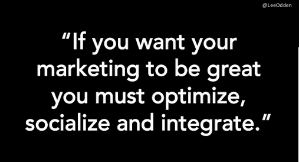 Figure out what your customers want, and give it to them. Monitor what works and what doesn’t. Adapt and optimize performance.
Figure out what your customers want, and give it to them. Monitor what works and what doesn’t. Adapt and optimize performance.
This would appear to be common sense marketing and yet, when you examine a lot of what gets published in the name of content marketing, social media and SEO, the “makes sense” doesn’t seem so common.
Over the past 3 weeks I’ve given presentations to audiences in the U.S., Spain, Russia and the UK. For just about every audience, there is a common language everyone seems to understand and if you can connect with that, it’s amazing what progress you can make.
Perhaps you’ve been in situations where you’ve followed a certain marketing process over and over again and after really looking at the “why” and for “who”, there’s a newly observed disconnect. I think that’s happened with a lot of digital marketers pressured to follow and create shiny new object strategies without alignment towards true brand and customer objectives. You know the drill: “Create more content”, “Grow our social networks”, “Rank high on search engines”.
The pivot from routine, mechanical to more inspired and meaningful is found through the customer journey. Balance customer insights with unique stories and content experiences that guide customers from attraction, to engagement to conversion. Help customers pull themselves through the buying cycle with information they want and enjoy.
Provide answers and create experiences. Create information and media that provide context and guide customers along the buyer’s journey from awareness to interest to consideration to purchase by answering their questions in a way that motivates them to the next step. Core to this kind of content approach is the customer behavior and how they discover, consume and act on information. Be the best answer for your customers, wherever they may be looking or influenced.
Walking the talk. At our digital marketing agency we’ve been implementing that kind of approach to varying degrees for numerous mid-market and several Fortune 500 businesses. Our experience working with companies like McKesson, Dell and recently, LinkedIn, have shown how going in with best practices must also be adaptable to ensure implementation of the tactics that will achieve the desired impact. What seems to resonate with everyone is a focus on optimizing for customer experience through high quality content that’s easy to find, engaging to consume and inspiring to share.
There’s a book about this. Anticipating customer information preferences and then optimizing for attract, engage, convert is what I cover in the book, Optimize: How to Attract and Engage More Customers by Integrating SEO, Social Media and Content Marketing. As a preview to the book and to provide online marketers some insight into this perspective, below is a presentation I did this week for Silverpop’s EMEA group in London. I even re-invoked the famous ZRobot example for buy cycle optimization.
Optimize & Socialize Your Digital Marketing for 2014
On the one hand, it makes sense to focus on customer insights and then anticipate content topics and media that will resonate to achieve a desired business outcome. This is the core of what modern content marketing is.
On the other hand, it’s also very important for brands to identify their core differentiators and unique selling proposition to be included in any customer focused narrative. Thanks to the education efforts of folks like Content Marketing Institute, marketers are becoming savvy about content marketing with customer segment-specific content plans covering each distinct buying journey.
To stand out, it’s important for content marketers to incorporate brand differentiators with the voice of the customer content. For example, if the persona “Executive Jane” prefers service over cost, it’s not enough to be the best answer for “service”. Your brand must differentiate itself in terms of the best service plus whatever it is that your company brings to that service to make it different (better for the customer) than the competition. It might be service + low cost + socially conscious if your company has social responsibility as a core value.
Are you optimizing across the buying cycle with content, search and social media yet? Have you incorporated your brand’s core differentiators into your digital marketing messaging? What successes (or challenges) are you seeing?


